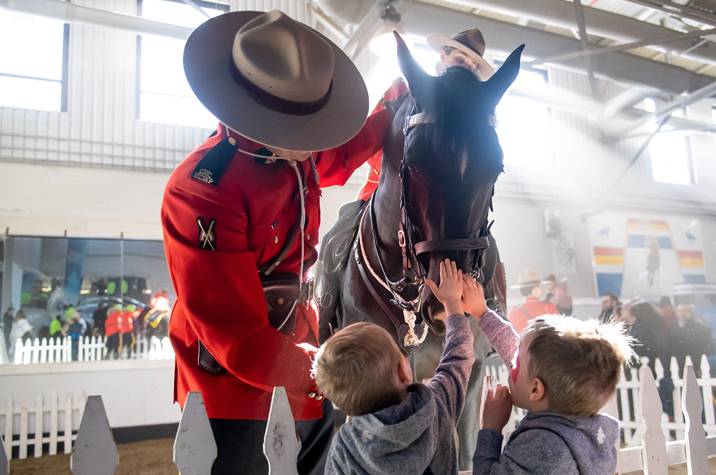The role of the RCMP horse in the past 150 years

RCMP Musical Ride performances and interactions with horses create unique spaces for interaction between front-line police officers and community residents.
Image by RCMP
June 26, 2024
Content
"You weren't a Mountie unless you could ride"
Starting with the iconic March West in 1874, Canada's national police force has depended on the horse to deliver on its ever-expanding mandate, prepare its officers for the rigours of day-to-day policing, recruit new employees, and build relationships with Canadians.
In the October 1948 edition of the RCMP Quarterly magazine, Riding Master Staff Sergeant C. Walker reflected on the essential role of the horse in establishing RCMP traditions: "We who serve in the RCMP, with the most up-to-date machines and methods at our disposal, may well review the problems of those earlier peace officers and marvel at the tradition they established. We might ask ourselves: How much of that tradition would have been our legacy had the North West Mounted Police (NWMP) been a dismounted unit?"
Relying on the hardy horse
In May 1873, disturbing stories of unbridled lawlessness led Prime Minister John A. Macdonald to create a new police force that would be mounted on "the hardy horse of the country." What MacDonald didn't know was those early mounts would be what authors William and Nora Kelly describe as "scruffy broncos" that bore little resemblance to today's "meticulously bred RCMP horses."
To further complicate matters, while many of the first recruits were accomplished horsemen with military training, many others - former clerks, gardeners, professors, students, and even a bartender - had no riding experience at all.
Stationed at Lower Fort Garry, just north of Winnipeg, Staff Constable Sam Steele was assigned the difficult tasks of breaking the horses and training the riders.
In his 1915 memoirs, Steele recalled the very physical challenges of horse training. "With very few exceptions, the horses had never been handled, and none but the most powerful and skillful dared attempt to deal with them. Even when we had them 'gentled' so as to let recruits mount, the men were repeatedly thrown with great violence to the frozen ground."
Between July and October 1874, those same hardy horses carried and hauled the weight of a 300-man trek across 1,300 kilometres of Canadian prairie. They suffered through extreme hunger and thirst, clouds of mosquitoes, and every type of weather imaginable. Many didn't survive.
Those that did helped Canada's frontier police force patrol almost 800,000 square kilometres of unsettled land to prevent whiskey trading, track down horse thieves, collect customs duties, and even deliver the mail.
That reliance on horses would continue for the next half-century, before the rapid emergence of the automobile after the First World War made animal transport obsolete.
Equestrian training at Depot
While its operational mandate would steadily decline through the 1920s and '30s, the horse clearly demonstrated its value. Moreover, the mounted rider emerged as an iconic symbol of the RCMP and the country.
"Without the horse, there's no way the March West is successful, and the North West Mounted Police has no role in bringing law and order to what were then called the Territories. Even into the 1940s, '50s, and '60s, you weren't a Mountie unless you could ride," says RCMP Historian Mark Gaillard.
Equestrian training remained one of the centrepieces of a new, more formalized training regimen introduced in 1932 at the RCMP Training Academy in Regina, known as Depot. Daily exposure to a horse, it was believed, would help to develop specific skills and aptitudes that were critical for any new police officer.
Horse training also came with significant financial costs, which led to the 1966 decision to shut down the program at Depot. The breeding farm was moved from the remount ranch at Fort Walsh, Saskatchewan to Pakenham, Ontario, where it continues to produce the distinctive black Hanoverians for the RCMP Musical Ride, one of the most widely recognized symbols of Canada.
Tradition of the RCMP Musical Ride
The origins of the musical ride date back to the formation of the first North West Mounted Police outposts. Initially performed to entertain the troops, the ride had its first official performance at the NWMP barracks in Regina in 1887. By 1904, when the police force was renamed the Royal North West Mounted Police, prairie fair-goers were treated to regular performances.
Following a break during the First World War, two troops of the RCMP offered public performances starting in 1920, one based in Regina and the other in Rockcliffe, just outside Ottawa.
"It's the horses that draw people in," says the Officer-in-Charge, Supt. Kevin Fahey. "They create unique spaces for conversation between front-line police officers and community residents, from toddlers to seniors. Those interactions around the horses build relationships, create positive impressions, and help to re-establish trust in places where it's been fractured or broken."
Superintendent Fahey recalls ride performances in Nova Scotia following the April 2020 tragedy in Portapique, where a lone gunman masquerading as a police officer killed 22 people.
"People in those areas suffered unspeakable heartache and, understandably, there has been a lot of scrutiny around RCMP actions related to that tragedy," he says. "What the ride did was bring our officers and the public together in ways that could start to rebuild relationships and gain back trust."
Recruiting officers are often on-site during public performances, eager to share information about the array of career opportunities in the RCMP. For Canadians of diverse backgrounds who line up for their chance at a photograph, the horses and riders present a welcoming environment for informal interactions with police.
"We're also conscious of the role the ride can play in supporting RCMP efforts at reconciliation with First Nations, Inuit, and Métis communities," adds Fahey. "We make every effort to organize tours in and around reserves and other locations that will allow for lots of positive interaction and relationship-building with Indigenous Peoples."